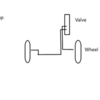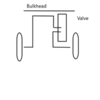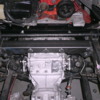I installed a brake proportioning valve on my car, in the front. It limits the front brake, it is adjustable. It workd very well
You want to limit the brake capability of the brakes that lock because the tires have lost traction due to excessive brake force. On a Mangusta and a Pantera, or any mid-engine car it is in the front, not the back like a rear wheel drive or front wheel drive car.
I shouldn't be interjecting myself into this discussion since everything I know of Mangusta's is second hand but the significant review of them that still sticks is the term, "trailing throttle oversteer".
This was experienced in my 930 and was the main reason I ditched that in favor of a Pantera but it is next to impossible to learn to put your foot into the throttle in a sweeper when you feel it starting to go to pull it up. Kind of like pulling a trailer when the wind starts to whip the trailer and you need to use MORE throttle to pull it up in line.
The Pantera uses a '72 Mustang brake proportioning valve, with the brake warning light installed in it, but that thing proportions a set 75/25 into the brake system.
The additional "correction" in bias is designed into the size of the braking capability by the size of the pads, i.e., the clamping capability of the system.
I can't prove it at this points, simply because you can only safely test on a closed track, but I wager you that you can ALMOST eliminate the rears on the Pantera from this system.
You guys don't like to hear about Ford's involvement in the Detomaso's or even Shelby's association with it at all. Sure...it's pure Italian. Right. But what you want to do is forget about why there is a proportioning valve in the front, left to right, and install an adjustable proportioning valve in the system for the rear.
This was done on the 65 and 66 GT350's and I can tell you that it is virtually impossible to lock the brakes up at all.
In the Pantera, you are better off going to the Mustang replacement master cylinder simply because you have a greater variety of bore diameters to experiment with.
Generally speaking, on a Pantera, IF you are increasing the braking in front, leave the rears alone, and look for a larger master bore.
The stock Girling master is likely to make a monster out of locking the fronts because of the greater breaking capabilities and softer pedal. The larger bore, because of the greater pedal effort, reduces pressure to the fronts. In effect is a proportioning valve.
I already know that a bore of 1" is about where you want to be on that bore diameter BUT you could start as low as 3/4" and step all the way up to 1-1/4" by 1/16" increments. Let me save you the time and effort. 1".
If you want to stay metric, fine but you aren't going to find a 25.4mm bore. Euro thinking is this case is very limiting. Go ahead. Be stubborn.
What it will do is shorten the pedal travel, harden the pedal some and reduce the tendency of locking up the fronts in a hard panic.
That's what you do on a race car and when putting higher performance brakes on the car, you are really putting "racing brakes" on it with the exception of a softer, street, pad like the Porterfield R4s pad.
In many respects, the Mangusta is a 1.0 Pantera.
As far as the Mangust rear brake line routing, why is it important to replace the exact "factory" routing.
You are just going to have a single rear line splitting into a T at some point along the chassis. That's all that should matter?




